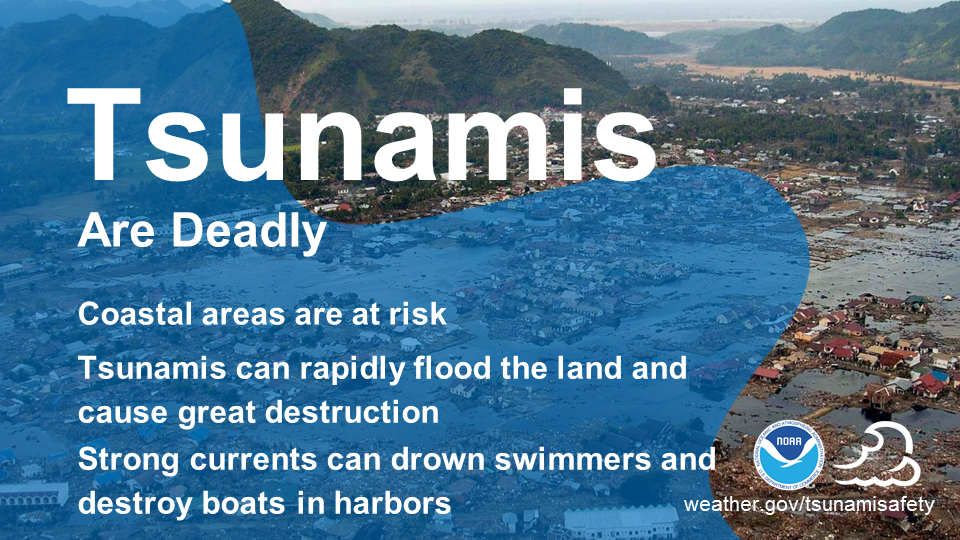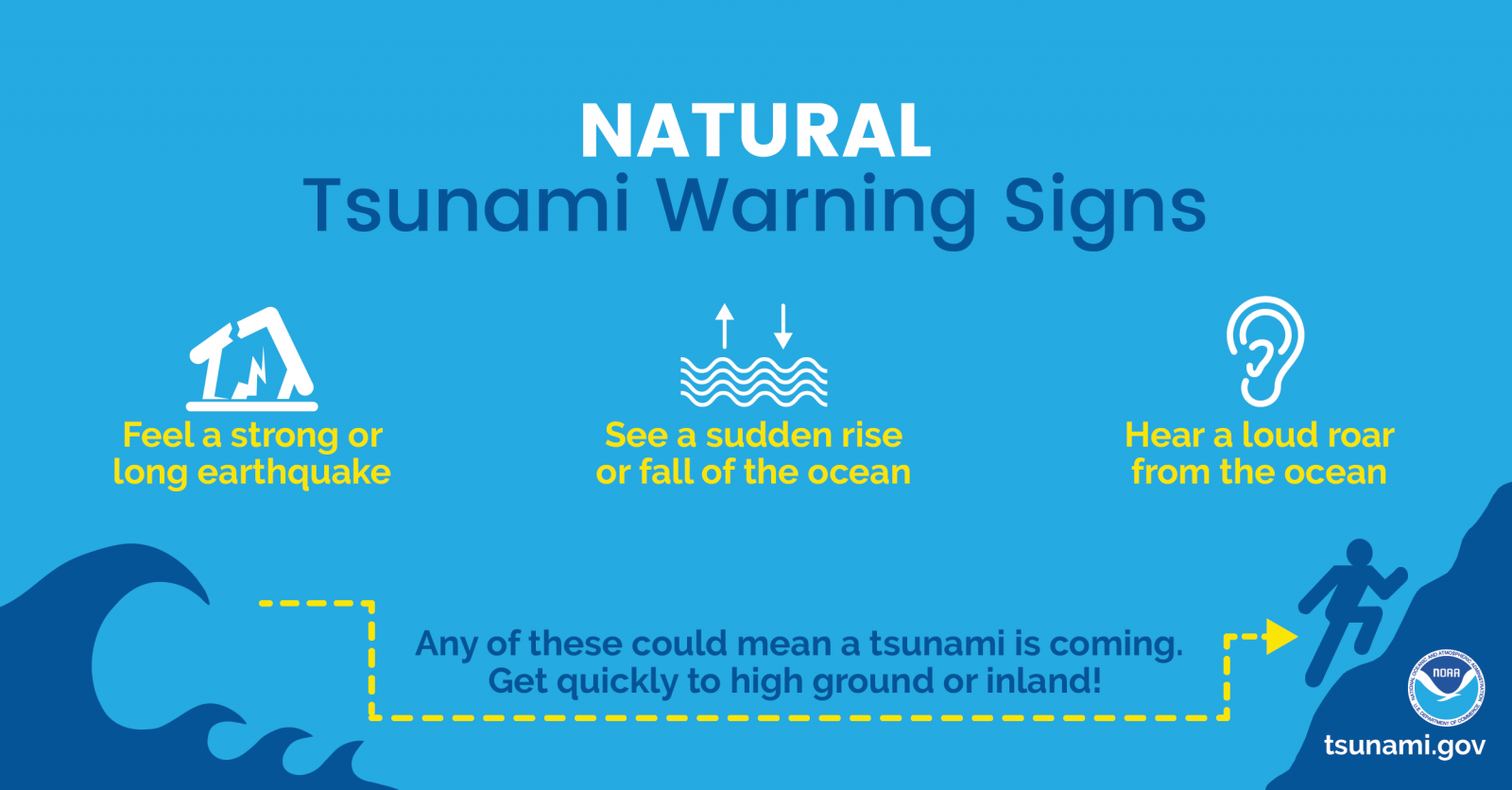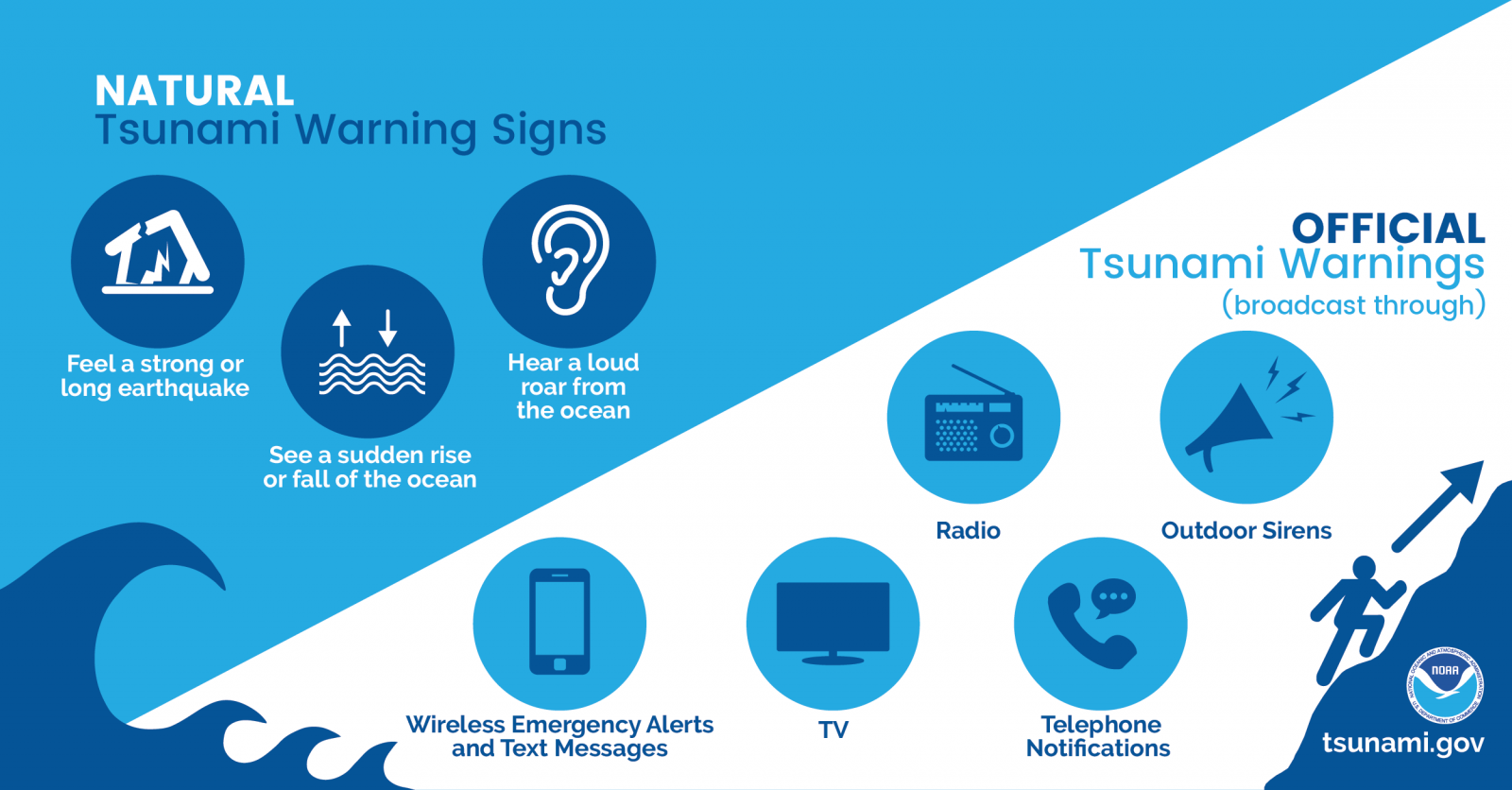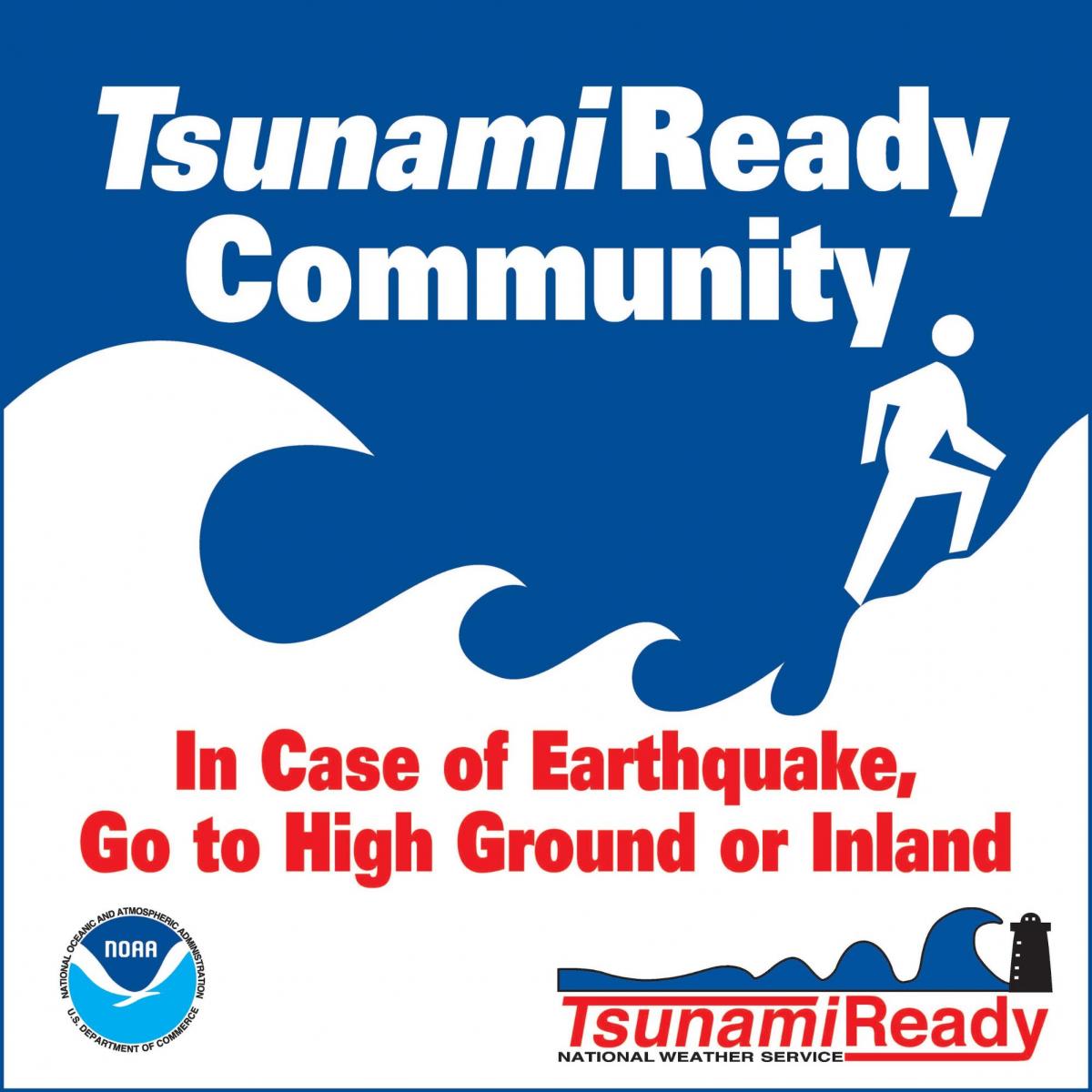Please help the NWS spread these important safety messages and posts about historic tsunamis on social media! Everyone is welcome to use the text and images provided below to help the NWS build a Weather-Ready Nation.
Facebook
Official tsunami warnings are broadcast through local radio and tv, marine radio, wireless emergency alerts, NOAA Weather Radio, and NOAA websites. They may also come through outdoor sirens, local officials, text message alerts, and telephone notifications. Learn about the four levels of tsunami alerts for the U.S.: weather.gov/safety/tsunami-alerts
Twitter
#Tsunami warnings come from many sources, some of which include local radio and TV, NOAA Weather Radio, and @NOAA websites. Learn about tsunami alerts to make sure you’re #WeatherReady: weather.gov/safety/tsunami-alerts

Facebook
A Tsunami WATCH means Be Prepared.
A Tsunami WARNING means Take Action!
weather.gov/safety/tsunami-alerts
Twitter
A Tsunami WATCH means Be Prepared.
A Tsunami WARNING means Take Action!
weather.gov/safety/tsunami-alerts #WeatherReady

Facebook
Tsunamis are rare but incredibly destructive, so know where to go if you’re by the coast. You are generally safer by going to official evacuation zones, higher ground, or further inland. Identify your safe places before a tsunami occurs. weather.gov/safety/tsunami
Twitter
Tsunamis are rare but incredibly destructive, so know where to go if you’re by the coast. You are generally safer by going to official evacuation zones, higher ground, or further inland. Identify your safe places before a tsunami occurs. weather.gov/safety/tsunami

Facebook
A tsunami can strike any ocean coast at any time throughout the year. While they don’t happen very often, they pose a major threat to coastal communities. Check out this video for things you can do to prepare. youtu.be/x0GX_kc7JZo
Twitter
A #tsunami can strike any ocean coast, any time. If you live, work, or play on the coast, you should prepare for a tsunami. youtu.be/x0GX_kc7JZo Be #WeatherReady!
Facebook
A tsunami can be very dangerous to life and property on the coast. It can produce strong and dangerous currents, rapidly flood the land, and cause great destruction. Even small tsunamis can be dangerous. Strong currents can injure and drown swimmers, and damage and destroy boats in harbors. weather.gov/tsunamisafety
Twitter
A #tsunami can produce unusually strong currents, rapidly flood the land and cause great destruction. Even small tsunamis can be dangerous. weather.gov/tsunamisafety Be #WeatherReady!

Facebook
If tsunamis are a threat in your community, you should include tsunami-specific preparations in your emergency plan. Learn the evacuation routes, identify safe places, and practice evacuating. weather.gov/safety/tsunami-before
Twitter
At risk from #tsunamis? Plan for and practice evacuation and be #WeatherReady. weather.gov/safety/tsunami-before

Facebook
What is a tsunami? A tsunami is not just one wave, but a series of extremely long waves caused by a large and sudden displacement of the ocean. Most tsunamis are caused by undersea earthquakes. There is no season for tsunamis. A tsunami can strike at any time along any coast and can be very dangerous to life and property. Learn more at weather.gov/safety/tsunami-about
Twitter
What is a #tsunami? It’s a series of extremely long waves that can strike any coast, any time, and can be very dangerous to life and property. Make sure you’re prepared and #WeatherReady weather.gov/safety/tsunami-about

Facebook
Do you live, work, or play on the coast? Do you know your community’s tsunami risk? Your community may have identified and mapped tsunami hazard and evacuation zones. Find links to tsunami maps at nws.weather.gov/nthmp/maps.html or ask your local/state emergency management office or your local NWS forecast office for more info.
Twitter
Live, work, or play on the coast? Know your #tsunami risk and evacuation zones to make sure you’re #WeatherReady: nws.weather.gov/nthmp/maps.html #TsunamiPrep

Facebook
Did you know the tsunami hazard exists for all coastal U.S. states and territories? The hazard level varies, but given the large number of people who live, work, and play on the coast, even where the hazard level is low, the consequences are high. Learn more about the hazard for your area: nws.weather.gov/nthmp/ushazard.html. #TsunamiPrep
Twitter
Could a #tsunami strike where you live, work, or play? Find out: nws.weather.gov/nthmp/ushazard.html #TsunamiPrep

Facebook
If a tsunami strikes, there may not be enough time for an official warning, so it is important to understand natural warnings. If you are at the coast and feel a strong or long earthquake, see a sudden rise or fall of the ocean, or hear a loud roar from the ocean, a tsunami may follow. Move quickly to high ground or inland, away from the water. weather.gov/safety/tsunami-before
Twitter
Know nature's #tsunami warnings: strong or long quake, sudden ocean rise or fall, ocean roar. weather.gov/safety/tsunami-before Make sure you’re #WeatherReady!

Facebook
In the event of a tsunami, some tsunami warnings will be official, while others will be natural. Both are equally important. Official tsunami warnings will tell you what to do. Get updates from local radio/TV or your mobile phone. Follow instructions from local officials. weather.gov/safety/tsunami-during
Twitter
Both official and natural #tsunami warnings are important. Learn how to respond to make sure you’re #WeatherReady: weather.gov/safety/tsunami-during

Facebook
Communication and education are important parts of the tsunami warning system. Through NOAA’s TsunamiReady program, a voluntary community recognition program, the National Weather Service works with communities to help them minimize the risk posed by tsunamis. Areas of emphasis include risk assessment, planning, education, and warning communications. Becoming #TsunamiReady can improve public safety and reduce tsunami losses. Learn more: weather.gov/tsunamiready/
Twitter
Becoming #TsunamiReady can improve public safety and reduce #tsunami losses: weather.gov/tsunamiready/ #TsunamiPrep

Facebook
Led by NOAA, the National Tsunami Hazard Mitigation Program (NTHMP) works to protect lives and reduce economic losses from tsunamis at the community level. The #NTHMP includes NOAA, FEMA, the USGS, and 28 U.S. states/territories. Through collaboration, coordination, and support to partner states/territories, the NTHMP focuses on three key functions: hazard assessment, warning guidance, and mitigation. Learn more: nws.weather.gov/nthmp/.
Twitter
The National Tsunami Hazard Mitigation Program aims to protect lives, reduce economic losses, and help you stay #WeatherReady nws.weather.gov/nthmp/

Facebook
Large tsunamis, like the one produced by the magnitude 9.1 Tohoku, Japan earthquake on March 11, 2011, can travel across oceans and cause damage on distant shores. In Japan, the earthquake and tsunami displaced more than 500,000 people, caused approximately $247 billion in damage, and resulted in a nuclear accident. Most of the 18,453 deaths were attributed to the tsunami. Outside Japan, there was very little loss of life due to warnings and evacuations, but in the U.S. there was more than $96 million in damage and one death. Watch: oceantoday.noaa.gov/tsunamistrikedestruction/
Twitter
3/11/2011: M9.1 #earthquake produced a #tsunami that devastated coastal Japan. Watch: oceantoday.noaa.gov/tsunamistrikedestruction/

Facebook
NOAA’s National Tsunami Warning Center was established because of the tsunamis produced by an earthquake in Alaska’s Prince William Sound on March 27, 1964. This is the largest recorded earthquake in U.S. history (magnitude 9.2) and the second largest in world history. The tsunamis devastated coastal communities in Alaska and caused approximately $1 billion in damage along the coasts of the United States, Canada, and Hawaii. More than 130 people died in Alaska, Oregon, and California due to the earthquake and tsunamis. youtu.be/Lac4Zs_CIdw
Twitter
3/27/1964 : #Tsunamis from 2nd largest recorded #earthquake (magnitude 9.2) caused damage from AK to CA and in HI. youtu.be/Lac4Zs_CIdw

Facebook
NOAA’s Pacific Tsunami Warning Center is largely a result of the tsunami produced by the magnitude 8.6 earthquake off Alaska’s Aleutian Islands on April 1, 1946. The tsunami was observed throughout the Pacific. Most of the 167 lives lost and $359 million in damage were in Hawaii, where wave heights reached 55 feet. tsunami.gov youtu.be/8Bi3o1HK0Ks
Twitter
4/1/1946: A magnitude 8.6 #earthquake off AK produced a Pacific-wide #tsunami. Hawaii was the hardest hit. youtu.be/8Bi3o1HK0Ks

Facebook
NOAA’s Global Historical Tsunami Database has information about tsunami events from 2000 BC to the present. Today in tsunami history, April 3, 1868, a large earthquake off the island of Hawaii generated a tsunami that washed away 108 homes and drowned 47 people on the island. Learn more about historical tsunamis: ngdc.noaa.gov/hazard/tsu.shtml
Twitter
4/3/1868: Large Hawaiian earthquake caused a #tsunami that washed away 108 homes and drowned 47 people. Learn more about historical tsunamis: ngdc.noaa.gov/hazard/tsu.shtml

Facebook
Most tsunamis are caused by large undersea earthquakes, like the one that struck off the coast of southern Chile on May 22, 1960. This quake, the largest ever recorded (magnitude 9.5) produced a tsunami that was observed around the world. Devastation was greatest in Chile, where loss of life may have exceeded 5,000. Lives were also lost in Japan (142), Hawaii (61), the Philippines (21), and California (2). Worldwide, damage was estimated at more than $8 billion. youtu.be/oeKewmAoBEM
Twitter
5/22/1960: Largest recorded #earthquake (magnitude 9.5) produced a #tsunami observed around the world: youtu.be/oeKewmAoBEM
